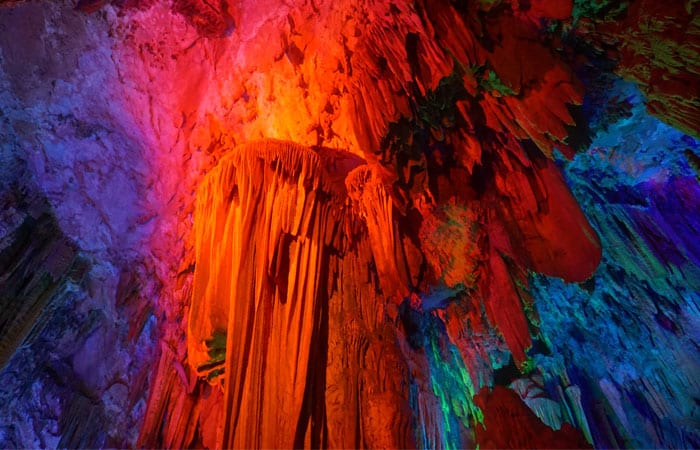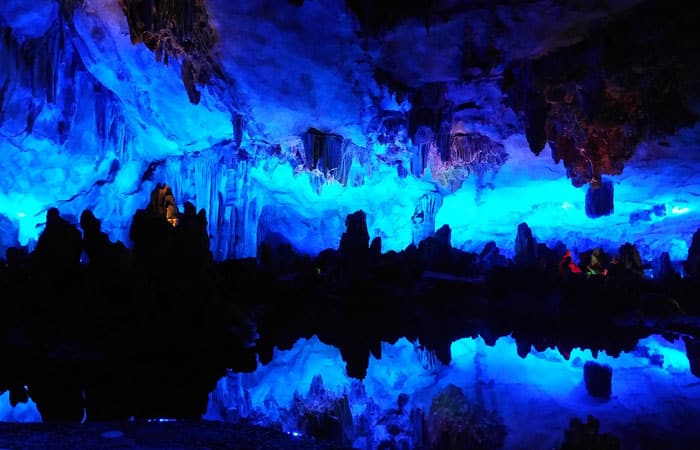Guilin is renowned for its spectacular natural attractions, and the Reed Flute Cave (also known as Lu Di Yan in Chinese) is one of its hidden gems. Stretching over an area of 262.5 yards (240 meters), this enchanting limestone cave features a dazzling display of rock formations that should not be missed by any visitor.
The Origin of Its Name
Despite what you might assume, the cave’s name has little to do with its interior marvels. Instead, it is derived from the lush reed grass growing outside, which local residents traditionally used to craft pipes and flutes. This charming connection to music gave rise to the name “Reed Flute Cave.”
A Historical Journey Through Reed Flute Cave
The cave is steeped in history. Within its walls, you can find over 70 inscriptions with elegant ink calligraphy dating back to the Tang Dynasty (618–907), marking Reed Flute Cave as an admired landmark even in ancient times. These ancient carvings have not only given the cave historical prominence but also attracted countless visitors over the centuries.
Historically, Reed Flute Cave served as a natural refuge. Its reed-covered entrance made it an ideal hideaway during times of conflict. Local residents sought shelter here during the turbulent periods of the Sino-Japanese Wars (including the 1937–1945 invasion) and even during World War II (1939–1945). In fact, the cave’s secure and natural enclosure has seen use by newspapers, hospitals, and printing companies during these challenging times.
Although visitors were recorded as early as the Tang Dynasty, the cave was officially opened to the public in 1962. Since then, millions of tourists have wandered its labyrinthine corridors, marveling at nature’s artistry.
The Geological Formation of Reed Flute Cave
Reed Flute Cave is the product of dramatic geological processes that started around 600,000 years ago when the site was an underground lake. Over time, as the surrounding mountains rose and the water levels receded, calcium carbonate deposits dissolved and crystallized to form the spectacular stalactites, stalagmites, and rock formations witnessed today. This slow but magnificent transformation has turned the cave into an otherworldly museum of natural art.
Through centuries of deposit accumulation and erosion, nature sculpted Reed Flute Cave into a marvel awaiting discovery.

Highlights: Attractions Inside the Cave
Tower-shaped Pine (Ta Song Ao Xue)
This is the most famous stalagmite in the cave, strikingly resembling a towering pine tree. Its delicate “branches” appear to be crafted out of snow and ice, creating a magical spectacle for visitors.
Crystal Palace
The Crystal Palace is a fantastic natural hall where stalactites hang in all four directions. Enhanced by vibrant lighting effects, this chamber carries legends of the Monkey King from the classic Journey to the West – where it’s said he battled the Dragon King to claim his magnificent weapon.
Ancient Inscriptions on the Cave Walls
The walls of Reed Flute Cave are adorned with poems and travelogues from the Tang Dynasty. These inscriptions add a layer of historical poetry and mystique to the overall experience.

What Awaits You Inside the Cave?
Regarded as one of Guilin’s top attractions, Reed Flute Cave welcomes you into a subterranean park of zigzagging paths, reflective ponds, charming bridges, and quaint pavilions nestled amid flourishing plants and gardens.
A Unique Spectacle of Color and Light
Plan to spend at least an hour exploring the cave, where multicolored lighting transforms each rock formation into a vivid masterpiece. The interplay of light and shadow on the natural sculptures creates an unforgettable experience.
Nature’s Own Art Palace
Often described as “Nature’s Art Palace,” the cave is a gallery featuring stalactites, stalagmites, stone pillars, and stone flowers, each unique in shape and character. Let your imagination roam as you discover each hidden corner.
The Charm of Poetic Naming
True to Chinese tradition, many spots within the cave have been given poetic names such as the Crystal Palace, Virgin Forest, Dragon Pagoda Flower, and Fruit Mountain. Some translations may seem whimsical or unusual – names like “A Bumper Harvest of Melons,” “Fish Tail Peak,” “Red Silk Mosquito Net,” or “Listening to Flute Music from a Secluded Place” add to the charm and cultural mystique of Reed Flute Cave.
Visitor Information and Tips
Before planning your visit, here is a handy guide to help you navigate your trip to this natural wonder.
| How to Get There? | |
|---|---|
| By Bus | City buses 3, 58, and 13 will take you to the Reed Flute Cave Station |
| By Sightseeing Bus | Departs every 30 minutes between 10:00 and 15:30 |
| Prices | |
| Adults | 90 Yuan |
| Children (3.9 ft – 4.6 ft) | 45 Yuan |
| Children under 3.9 ft | Free |
| Opening Hours | |
| April to November | 7:30–18:00 |
| December to March | 08:00–17:30 |

For an extra special memory, visit the Crystal Palace or the Flower and Fruit Mountain spots inside the cave, where you can purchase professional souvenir photos (using specialized equipment and lighting) for just a few RMB. Additionally, many visitors take home small reed flutes and carefully selected stone pieces as unique mementos from one of Guilin’s most celebrated attractions.
Have you ever explored a limestone cave as mysterious as this one? Share your experiences and impressions in the comments below, and feel free to ask any questions – our professional guides are here to help!






